

Pennsylvania Department of Environmental Protection
Welcome!
The mission of the Pennsylvania Department of Environmental Protection (DEP) is to protect Pennsylvania’s air, land and water from pollution and to provide for the health and safety of its citizens through a cleaner environment. We will work as partners with individuals, organizations, governments and businesses to prevent pollution and restore our natural resources. This annual report presents the trends in Pennsylvania's Oil and Gas Industry, and summarizes the detailed information found at DEP's Oil and Gas website
Please scroll down to view the annual report, or use the top menu to jump to a topic. If problems are encountered while viewing content, please try opening the website using another web browser.
Disclaimer: The information contained in this report is based on the data contained in DEP information systems at the time of the publication of this report, including, but not limited to, DEP's enterprise-wide permitting and compliance database called eFACTS (Environment Facility Application Compliance Tracking System). As some data contained in these systems are self-reported by operators and other permitees, data in this report reflects the data as reported to the department.
Message From the Acting Secretary
DEP's Office of Oil and Gas Management administers an internationally recognized oil and gas program that includes the Bureau of Oil and Gas Planning and Program Management and the Bureau of District Oil and Gas Operations.
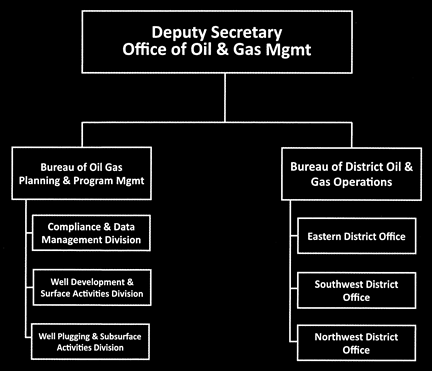
The Bureau of Oil and Gas Planning and Program Management is located in DEP's central office (Harrisburg) and is responsible for administrative, policy and regulatory development functions. The Bureau of District Oil and Gas Operations consists of three district oil and gas offices and is responsible for permitting, inspection, compliance and enforcement functions.
Before an operator may begin drilling a well, it must first submit the proper permit applications to DEP for review and approval. There are different types of permits related to oil and gas activities including, but not limited to, an:
The number of unconventional well drilling permits issued in 2016 decreased 59% since 2014. The total number of conventional well drilling permits issued in 2016 decreased 87% since 2014.
1,321 - Unconventional well drilling permits issued in 2016.
158 - Conventional well drilling permits issued in 2016.
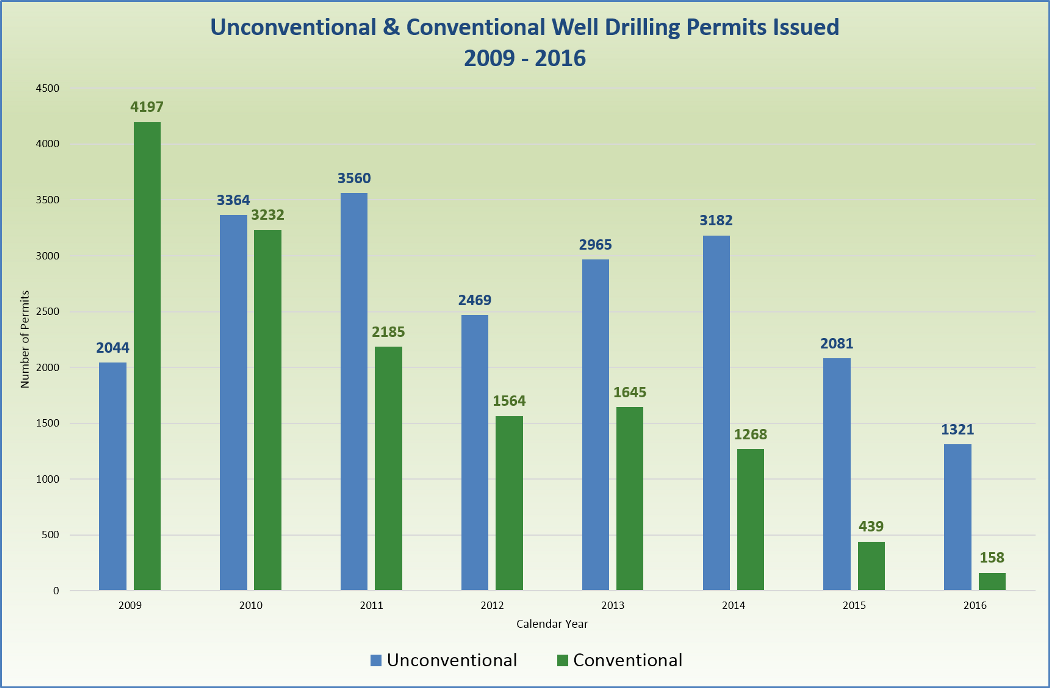
DEP inspects oil and gas well sites to ensure they are constructed and operated in accordance with approved permits. The total number of inspections increased about 2.8% from 2015 to 2016.
35,556 - Number of compliance inspections conducted in 2016.
The number of compliance inspections has significantly increased from 2010 through 2016. In 2010, oil and gas inspectors conducted a total of 16,504 inspections and this number rose to 35,556 inspections in 2016; more than twice as many inspections. The large number of administrative/well site inspections in 2015 is a result of an inspection initiative conducted by the Office of Oil and Gas Management. Specifically, DEP conducted enforcement and outreach to operators that failed to submit their 2014 production data and annual well integrity reports as required by law. In 2015, DEP issued 3,363 Notices of Violation to conventional operators and 83 Notices of Violation to unconventional operators that did not submit production reports. Additionally, DEP issued about 400 Notices of Violation to unconventional and conventional operators for failure to submit well integrity reports in 2015. DEP will continue to monitor compliance.

DEP is committed to working with oil and gas operators to ensure well sites operate in compliance with all applicable laws and regulations. DEP routinely provides compliance assistance through outreach and training opportunities.
Although the number of compliance inspections has increased over the past six years, the number of violations observed has been generally decreasing over this same time period. One notable exception to this decreasing trend pertains to the number of violations observed at unconventional and conventional wells in calendar year 2016. Violations increased in 2016 for both unconventional and conventional well violations. To view all conventional and unconventional well violations from 2016, click here .
.
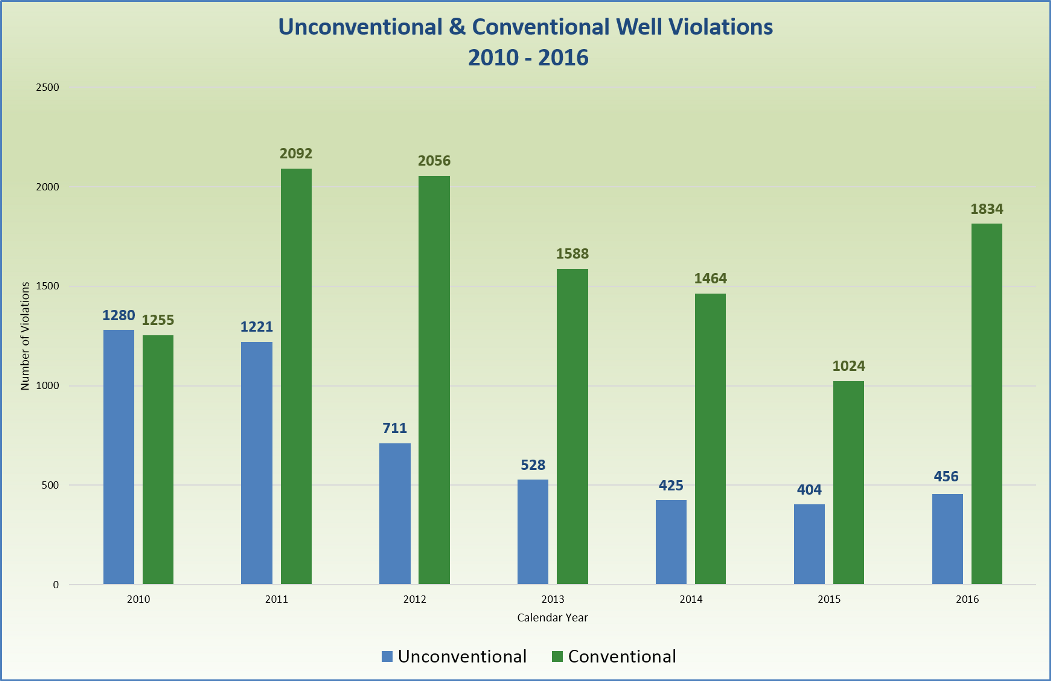
Since 2009, DEP has collected about $31.2 million as a result of noncompliance at oil and gas sites in Pennsylvania. These fines and penalties are used to reimburse operating costs that are incurred by DEP in the oversight of oil and gas and related environmental programs.
$9,688,573 - Total fines collected in 2016 as a result of violations.
The fines and penalties collected in calendar year 2014 and 2016 are a result of significant violations observed at a relatively small number of enforcement actions. For example, in 2016 nine violations resulted in the levy of about $8.4 million of the $9.7 million collected in total during 2016.
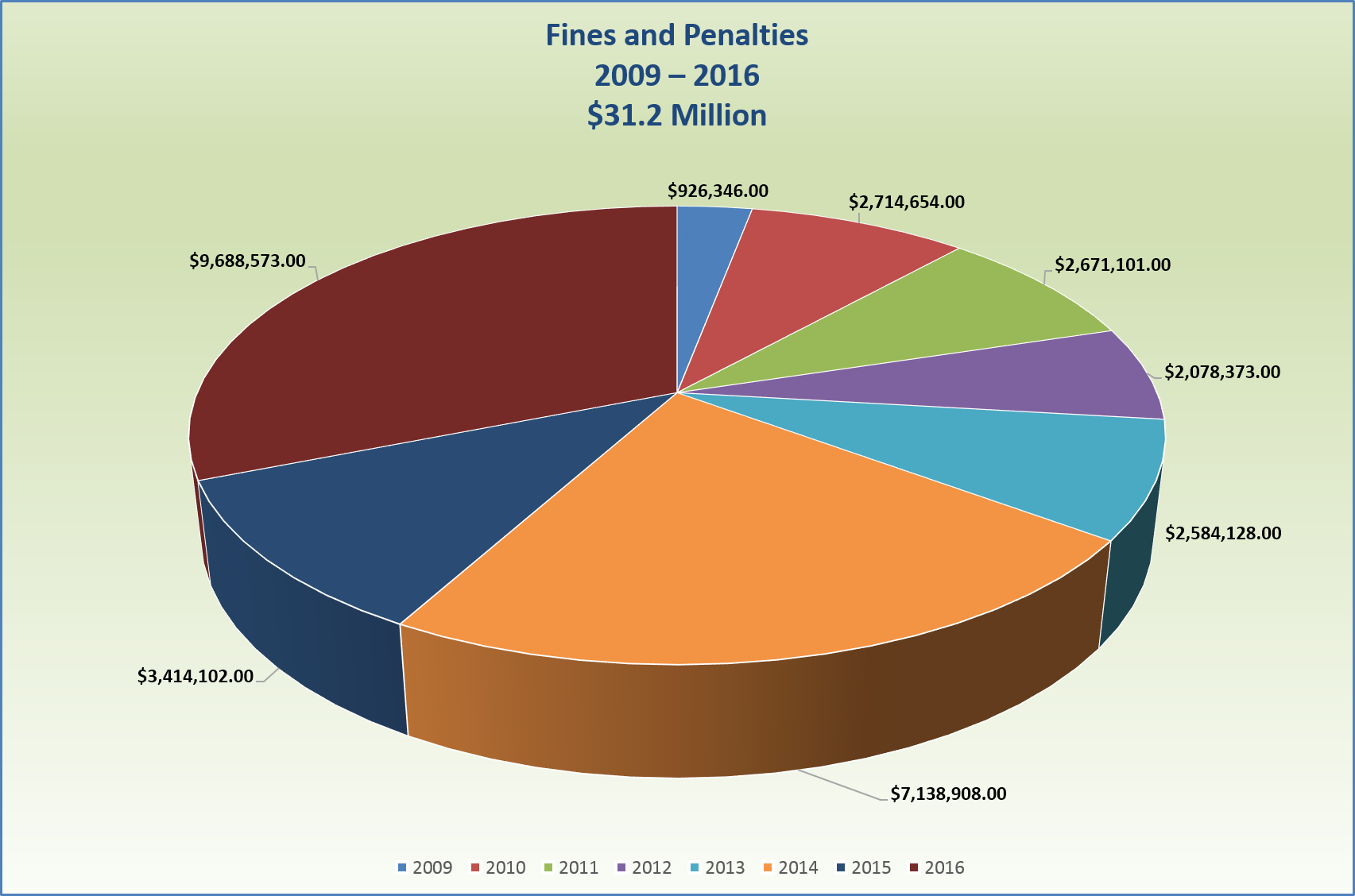
What We Accomplished in 2016
Click on a calendar month below to view detailed accomplishments.












Where are Pennsylvania’s oil and natural gas reserves located?
The nation’s first oil well was drilled in 1859 by Edwin Drake in Titusville, PA. Today, most oil in Pennsylvania is produced in the northwest corner of the state. This area is commonly called the oil patch since it is home to the largest number of active oil wells.
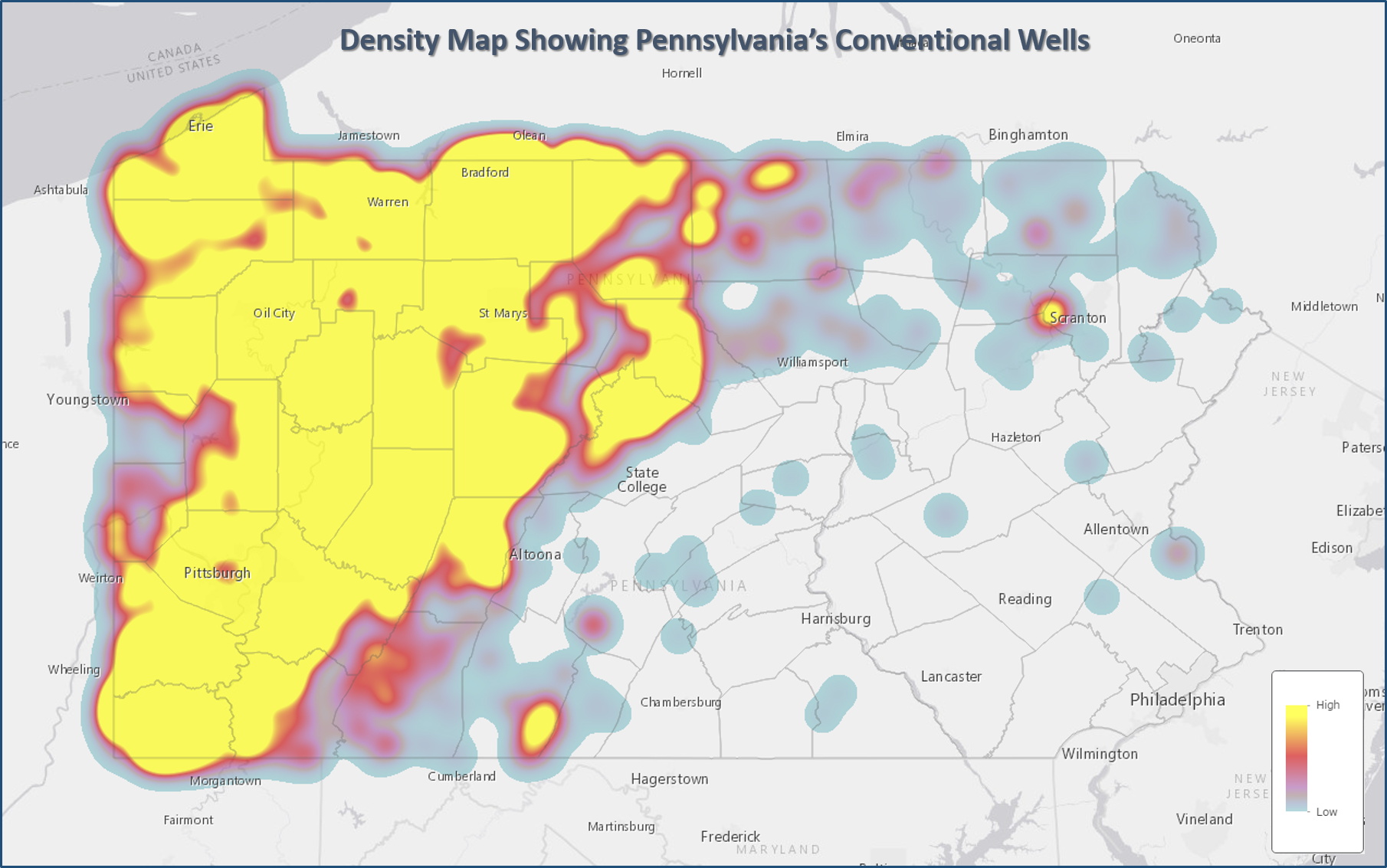
Pennsylvania's Shale Plays
Starting in 2006, operators began producing natural gas from the Marcellus shale formation which extends from the southwest to northeast corners of the state. There are other shale formations in the state, such as the Utica shale formation, that contain substantial reserves of natural gas. Pennsylvania’s shale formations are expected to produce natural gas for many decades into the future.
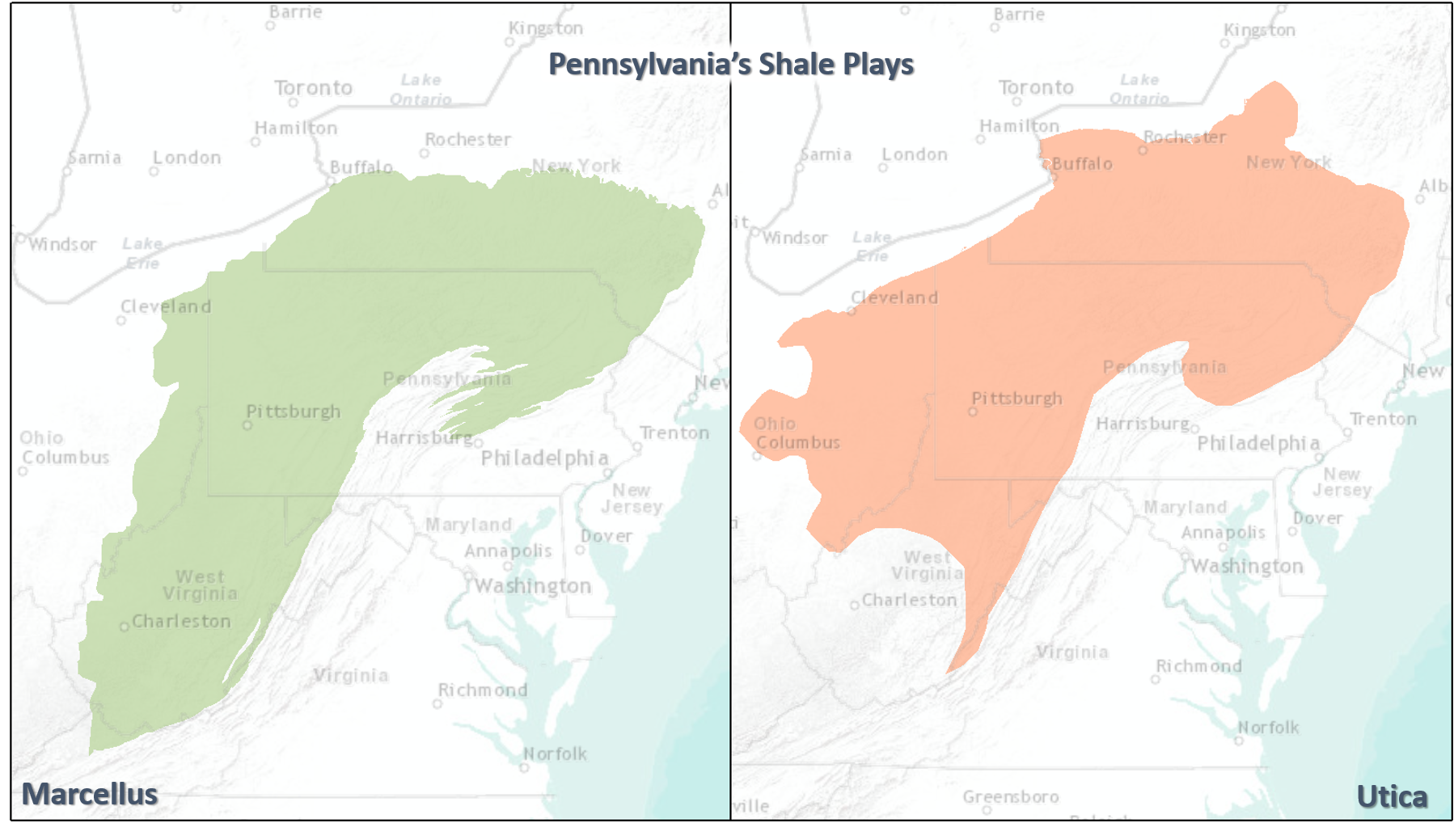
What is a Conventional vs. an Unconventional Well?
Conventional Wells
A conventional well is typically a well that is drilled vertically into a shallow oil or gas reservoir.
Conventional wells are constructed on much smaller well pad sites than unconventional wells. Most conventional wells do not require large volumes of water for hydraulic fracturing and do not employ horizontal drilling techniques.
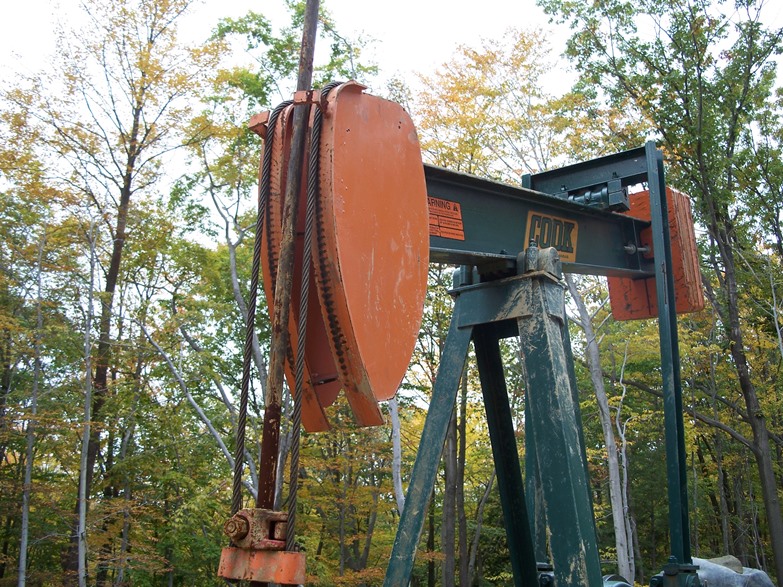
Unconventional Wells
An unconventional well generally refers to a well that is drilled deep into shale formations to produce natural gas. A distinction of these wells is that they involve horizontal drilling techniques and use large volumes of water under high pressures to hydraulically fracture (commonly called “fracking”) the shale rock to access large volumes of natural gas.
Where Are Oil and Gas Wells Located in Pennsylvania?
Shown to the right are thumbnail images of the Conventional, Unconventional and Utica and Point Pleasant wells drilled by county. For a high-level view of where conventional oil and gas wells were drilled during calendar year 2016, click on any map to view a larger interactive version. Wells drilled in 2016 appear as "squares" and wells drilled prior to 2016 appear as "circles". The Utica/Point Pleasant map depicts only those wells drilled in 2016.
DEP developed an interactive GIS mapping tool that can be used to locate oil and gas wells that are located in Pennsylvania. In addition to specific well locations, this tool provides much more information including production data, inspection results and compliance actions taken by DEP, and more. To learn about this tool, check out the tutorial![]() and begin using this interactive map today
and begin using this interactive map today . To see the trend in the number of wells drilled from 2009 through 2016, click the button below.
. To see the trend in the number of wells drilled from 2009 through 2016, click the button below.
What is a Class II Underground Injection Control (UIC) Disposal Well?
A Class II UIC disposal well is used to dispose of produced fluids (i.e., brine fluids) that flow back to the surface after a well is hydraulically fractured. In 2016, about 88 percent of all produced fluids was reused or recycled and reused in the production/hydraulic fracturing of other natural gas wells. About five percent was disposed in Class II UIC disposal wells, about five percent was treated (wastewater treatment), and the remaining two percent was managed using other methods such as dust suppression on roads, storage and disposal. Only produced fluids from conventional wells are allowed to be used for dust suppression on roads.
The U.S. Environmental Protection Agency is responsible for reviewing and approving Class II UIC permit applications in Pennsylvania; however, DEP also reviews the EPA permits to ensure state regulatory requirements are met prior to issuing a permit for well usage.
DEP’s permit review also involves a review of the Control and Disposal Plan, Erosion and Sedimentation Control Plan, Casing and Cementing Plan, Geologic Analysis and Mechanical Integrity Analysis to ensure the well can accept the produced fluid at proposed rates and pressures.
Where Are Class II UIC Disposal Wells Located in Pennsylvania?
Currently, there are eight active and two inactive Class II UIC disposal wells located in Pennsylvania.
| Operator | Permit Status | Municipality | County | |
|---|---|---|---|---|
| 1 | Bear Lake Properties, LLC | Active | Columbus Township | Warren |
| 2 | Bear Lake Properties, LLC | Active | Columbus Township | Warren |
| 3 | CNX Gas Co., LLC | Active | Jenner Township | Somerset |
| 4 | Columbia Gas of PA, Inc. | Active | South Beaver Township | Beaver |
| 5 | Cottonwood OPR Corp. | Active | Stonycreek Township | Somerset |
| 6 | EXCO Resources PA, LLC | Active | Bell Township | Clearfield |
| 7 | Seneca Resources Corp. | Active | Highland Township | Elk |
| 8 | Pennsylvania General Energy | Active | Grant Township | Indiana |
| 9 | EXCO Resources PA, LLC | Regulatory Inactive | Ferguson Township | Clearfield |
| 10 | Stonehaven Energy Mgmt Co., LLC | Inactive Not Operating | Cranberry Township | Venango |
Neighboring states contain many more active UIC disposal wells compared to Pennsylvania. For example, Ohio has more than 200 and West Virginia has 45 active UIC disposal wells, respectively. Most produced fluids from Pennsylvania that are disposed in Class II UIC disposal wells are transported to neighboring states. To view waste production reports by operator, county or waste facility click here
DEP is currently conducting a technical review for the following three Class II UIC disposal well permit applications.
| Operator | Permit Status | Municipality | County | |
|---|---|---|---|---|
| 1 | Sammy-Mar, LLC | Under Review | Huston Township | Clearfield |
| 2 | Windfall Oil and Gas, Inc. | Under Review | Brady Township | Clearfield |
| 3 | Bear Lake Properties, LLC | Under Review | Columbus Township | Warren |
How Much Natural Gas is Produced in Pennsylvania?
Although natural gas has been produced for many years using conventional drilling methods, it was not until 2006 that the first unconventional natural gas well was drilled in Pennsylvania. It did not take long before natural gas operators began exploring and producing large amounts of natural gas from the Marcellus Shale play and other shale plays.
The volume of natural gas recovered from Pennsylvania’s shale plays has steadily increased over the past eight years and much more natural gas remains available for future exploration and development.
In 2016, about 5.1 trillion cubic feet of natural gas was produced from unconventional gas wells in Pennsylvania. Although the number of new unconventional natural gas wells drilled in Pennsylvania dropped to its lowest level since 2008, natural gas production climbed to its highest level on record in 2016.
Currently, Pennsylvania is the second largest producer of natural gas in the nation (Texas produces the most).
To query production information related to natural gas, condensate, oil and waste for each permitted well, click here
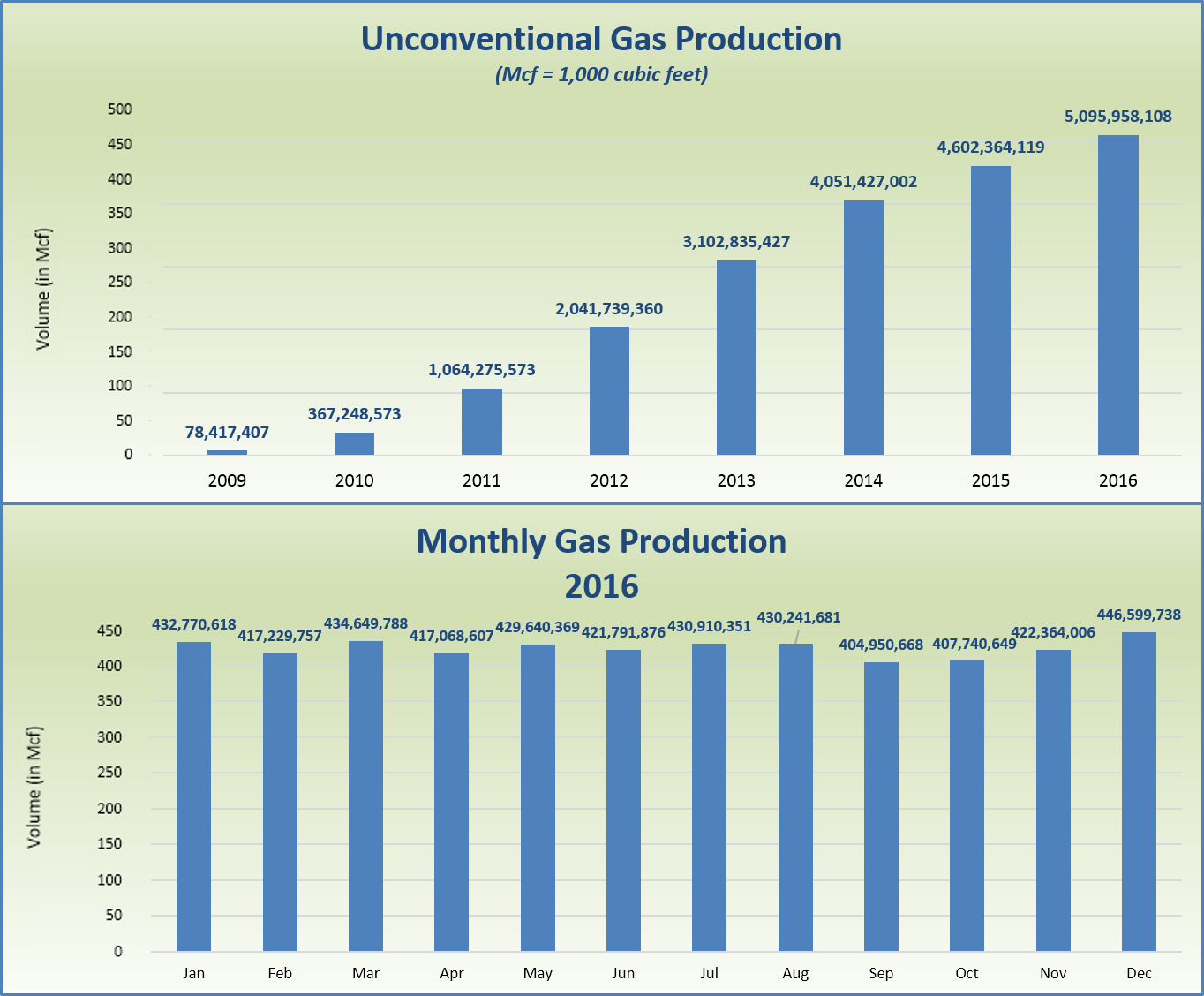
What Happens When a Well Stops Producing Oil or Gas?
Eventually, active oil and gas wells stop producing oil and gas or become uneconomical to operate. When Pennsylvania’s Oil and Gas Act of 1984 was enacted, regulations were created to require the plugging of such wells. Although operators are required to post bonds with DEP to ensure that wells are properly plugged at the end of their useful life, this was not always the case. Legacy oil and gas wells are discussed in more detail in the section of this report called “Legacy Well Identification.”
DEP has spent over $33 million since 1989 to administer Pennsylvania’s orphan and abandoned oil and gas well program, but much work remains. DEP collects a small surcharge on each well drilling permit for the purpose of plugging unsafe orphan and abandoned wells and DEP’s Growing Greener program has also contributed more than 13 million dollars toward well plugging projects from 2000 through 2013. In 2015, DEP spent $784,752 to plug 46 orphan and abandoned wells and in 2016 it spent $1,029,166 to plug 23 wells. Given the estimated hundreds of thousands of orphan and abandoned oil and gas wells that are suspected to exist in Pennsylvania, there is not enough funding currently available to DEP to plug the remaining wells. Unless additional monies are identified for this purpose, the universe of orphan and abandoned wells will remain unplugged and will be a potential environmental and safety threat for many decades to come.
Can I Review Forms and Reports that DEP Receives from Unconventional Oil and Gas Operators?
Yes. Pennsylvania’s oil and gas regulations require unconventional operators to submit to DEP electronically various forms, requests and reports such as completion reports and well records.
DEP developed a search tool called "eSubmissions" to allow the public to view the forms and reports that are submitted to DEP electronically. To view this search tool, go here
Can I Review Notifications that DEP Receives from Oil and Gas Operators?
Yes. All oil and gas well operators are required to submit advanced notification of spud dates to the DEP electronically. Additionally, operators of unconventional wells are required to electronically notify DEP in advance of conducting various operations such as casing and cementing a well, hydraulically fracturing a well and abandoning or plugging a well.
To review the spud notifications report, go here
Enhancements were made to DEP’s Greenport applications during 2016 to enable DEP to receive new notifications required by the promulgation of Chapter 78a. To view the "eNotifications" report, go here
Where Can I Access Online Reports?
DEP has developed many useful interactive reports to enable the public to quickly search DEP’s databases. The reports include the ability to view oil and gas permits that have been issued, locations of wells that are drilled, locations of orphan and abandoned wells and natural gas production reports to name a few. Visit DEP’s website

Webinars & Oil and Gas Technical Advisory Board (TAB)
The public may participate in Oil and Gas Technical Advisory Board Meetings either in person or by Webinar. These meetings routinely involve discussions about proposed oil and gas regulations, policies and other related topics. DEP’s Office of Oil and Gas Management periodically offers stakeholders and the public opportunities to participate in Webinars regarding other general oil and gas topics.
To attend a future TAB meeting via Webinar, go here
You may register for upcoming Webinars and view many prior ones here
eComment
DEP encourages the public to provide constructive comments about regulations, policies, technical guidance, general permits, and other proposals that are under development. To access the full text of such documents, submit comments, and see comments from other individuals, please visit the DEP website to access the eComment tool here
eNotice
DEP developed an electronic notification system for the public to use to stay up-to-date with many types of environmental topics. This tool is called eNOTICE and you may register to receive free notifications of important actions the Department takes. It’s easy. Go here 
DEP Newsletter
DEP publishes a biweekly newsletter that features information about hot topics, recent department actions, regulatory updates, webinars and upcoming events. To subscribe to this free newsletter, click here
Legacy Well Identification
As a result of the oil and gas drilling booms during the mid-nineteenth and early twentieth centuries, hundreds of thousands of oil and gas wells were drilled in Pennsylvania. Over the past 150 years, many of these wells were abandoned by their owners without notifying DEP or other state agencies. DEP estimates that as many as 560,000 abandoned oil and gas wells exist in Pennsylvania that remain unaccounted for. These legacy orphan and abandoned wells can lead to pollution to the environment if they are not properly plugged.
DEP has located 11,872*orphan and abandoned wells and is working diligently to identify the location of the many remaining wells. Unfortunately, given its current resources, it will likely take DEP many years to locate all of Pennsylvania’s legacy wells.
*Unplugged orphan/abandoned wells = 8,832 (source: DEP eFACTS database). Plugged orphan/abandoned wells = 3,040 (source: well plugging certificates from contracts issued)
One way the public and industry can help DEP to expand its inventory of known legacy wells is to report the location of such wells when they are discovered. If you come across a well on your property or when you are on other public lands that you believe is an orphan or abandoned well, please let DEP know. Contact a DEP District Oil and Gas representative at the telephone number listed in the below Fact Sheet.
Click on the play button above to view the slideshow of abandoned oil and gas wells.
Water Supply Impacts
DEP is committed to the protection of environmental resources including private water supplies. The Oil and Gas Act of 2012 (Act) contains language that holds oil and gas operators responsible for restoring or replacing water supplies when it is determined that oil and gas activities are the cause of contamination. The Act goes a step further and presumes that an oil and gas operator is responsible for contamination of water supplies located within prescribed distances and timeframes; unless the operator can clearly demonstrate that it is not responsible for the contamination.
Although there is no evidence that hydraulic fracturing has resulted in a direct impact to a water supply in Pennsylvania, there are cases where related oil and gas activities have adversely affected private water supplies. DEP investigates all stray gas-related complaints and if it is determined that a water supply is adversely affected by oil and gas activities, DEP works with the responsible operator to ensure the water supply is restored or replaced.
Contact Us...
To report any cases of suspected water contamination that may be associated with the development of oil and gas resources or any other environmental complaint, call DEP’s statewide environmental hotline at 1-866-255-5158.
To report an environmental emergency to DEP, click on the button below, and call the appropriate regional emergency contact number.
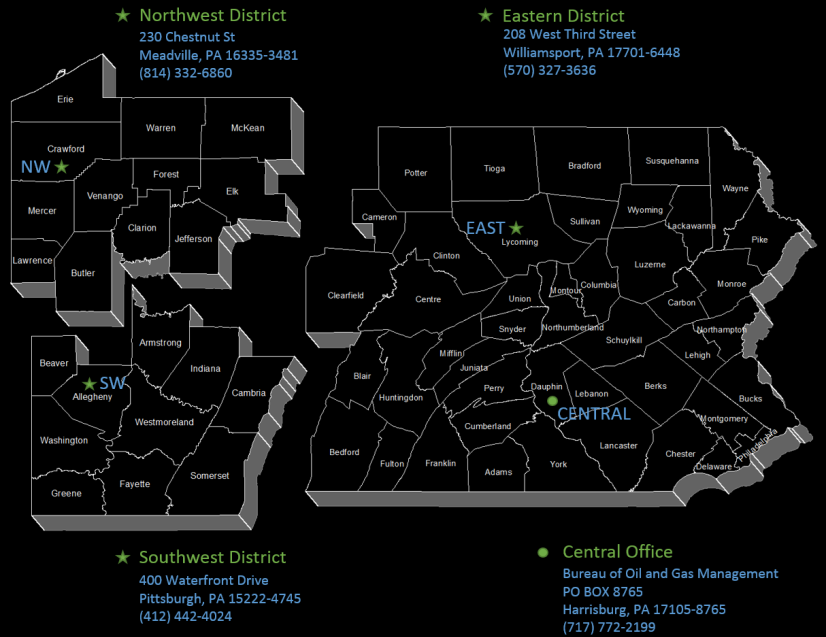
What's Next for 2017
We hope you found this annual report to be informative and useful. This past year was another busy one for DEP, but there is more to be done. DEP and the Office of Oil and Gas Management look forward to continue serving the citizens of Pennsylvania in 2017 through the work that we do to carry out the mission of the Department!
Pennsylvania Department of Environmental Protection
Office of Oil and Gas Management
Key Facts
Complement: 190 employees
Organization: Central Office – Bureau of O&G Planning and Program Mgmt. - Harrisburg
Eastern District Oil and Gas Office – Williamsport
Northwest District Oil and Gas Office – Meadville
Southwest District Oil and Gas Office – Pittsburgh
Funding: Fees, Fines/Penalties and Impact Fee Revenue
Well Drilling Permit Fees: $7,910,959 (FY2015-16)
Orphaned/Abandoned
Permit Fees: $490,121 (FY2015-16)
Penalties Collected: $9,688,573
Penalties Deposited to
Well Plugging Fund: $4,076,710 (FY2015-16)
Impact Fees: $6 million annually
PA Natural Gas Production (unconventional): 5.1 trillion cubic feet
Avg. # Wells Reporting Gas Production (unconventional): 7,143
PA Natural Gas Production (conventional): 107 billion cubic feet
Avg. # Wells Reporting Gas Production (conventional): 56,706
PA Oil Production (total): 1.1 million barrels
Avg. # Wells Reporting Oil Production (total): 16,721
Permits Issued:
Unconventional Drilling Permit 1,321
Conventional Drilling Permit 158
Stream Crossing & Encroachment (Individual Permits) 41
Stream Crossing & Encroachment (General Permits) 357
Erosion and Sediment Control General Permit (Expedited) 217
Erosion and Sediment Control General Permit (Standard) 158
Inspections:
Unconventional Inspections 15,192
Conventional Inspections 15,989
Well Site/Administrative Inspections 4,375
Total Inspections 35,556
Violations:
Unconventional 456
Conventional 1,834
Well Site/Administrative 778
Total Violations 3,068
Wells Drilled:
Unconventional 504
Conventional 92
Total Wells Drilled 596
Unconventional (total on record) 10,109
Conventional (total on record) 193,645
# Active Permitted Class II Disposal Wells in PA: 8
# Class II Disposal Permit Applications Under Review: 3
# Orphaned/Abandoned Wells in PA (estimated): ≤560K
# Orphaned/Abandoned Wells on DEP List (Identified/Ranked) 8,832
# Orphaned/Abandoned Wells Plugged 3,040
NOTE: Unless otherwise specified, all information is reported for calendar year 2016.
Additional Resources
Please visit other DEP Oil and Gas related websites.
Social Media
Use the share button at the top to share this report with others, and click on the buttons below to follow the latest PA DEP activities.

 – To construct a well site.
– To construct a well site. – To drill the well.
– To drill the well. – To build bridges and pipelines that cross waterways.
– To build bridges and pipelines that cross waterways.